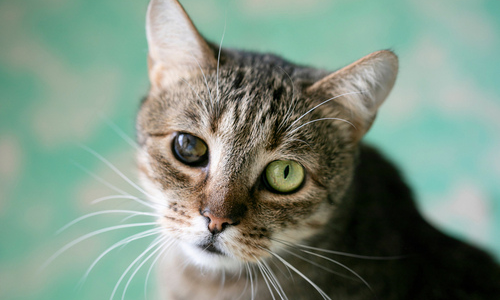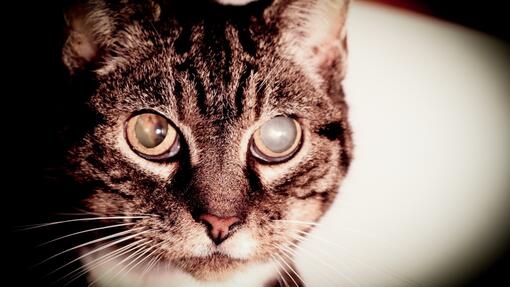Glaucoma in cats is a disease of the eye characterized by increased pressure within the eye, known as intraocular pressure (IOP). Without medical treatment, most cats with glaucoma will ultimately go blind in the affected eye.
However, the prognosis depends on the underlying cause of the glaucoma, and constant medical treatment is necessary to control the disease. Home remedies are not recommended, and veterinary attention should be sought immediately. The cost of glaucoma treatment for cats can vary depending on the specific case.
Glaucoma can occur at any age in cats and is typically caused by impaired drainage of the watery fluid in the eye.

Credit: www.companionanimalhospitaltamaqua.com
Introduction To Glaucoma In Cats
Glaucoma in cats can result in decreased appetite, red eyes, and squinting. While medical treatment can help control the disease, most cats will eventually go blind in the affected eye. Immediate veterinary attention is recommended for cats experiencing glaucoma.
Definition Of Glaucoma
Glaucoma is a disease of the eye in which the pressure within the eye, called the intraocular pressure (IOP), is increased. Intraocular pressure is measured using a tonometer and is typically around 10 to 20 mmHg in healthy cats.
Causes Of Glaucoma
Glaucoma in cats is considered to be almost invariably due to impaired aqueous humor outflow. This can be caused by various factors, including:
- Genetic predisposition
- Eye injuries or trauma
- Inflammation or infection in the eye
- Tumors or masses in the eye
- Certain medications
Symptoms Of Glaucoma
Feline glaucoma is a condition in which the watery fluid contained in the front part of the eye, just behind the lens, is unable to drain normally. This leads to an increase in intraocular pressure and various symptoms, such as:
- Dilated pupil
- Bulging eyes
- Squinting
- Red eye
- Cloudy eye
- Eye discharge
- Loss of vision
- A firm eyeball
- Decreased appetite
It is important to note that the symptoms may vary depending on the severity and underlying cause of the glaucoma.

Credit: www.purina.co.uk
Diagnosis And Treatment Of Glaucoma In Cats
Diagnosing and treating glaucoma in cats requires immediate veterinary attention and long-term medical treatment to manage the disease. Without treatment, most cats will eventually go blind in the affected eye. Home remedies are not recommended without professional examination.
How Glaucoma Is Diagnosed In Cats
Glaucoma in cats can be difficult to diagnose as the early symptoms are often subtle and easily overlooked. However, there are several diagnostic techniques that veterinarians use to determine if a cat has glaucoma. One of the most common methods used is tonometry, which measures the intraocular pressure (IOP) within the eye. This is done by using a tonometer, which can be either handheld or attached to a slit lamp microscope. The veterinarian will apply a small amount of local anesthesia to the cat’s eye, and then gently touch the cornea with the tonometer to obtain a pressure reading. Elevated IOP is a key indicator of glaucoma. Another diagnostic tool is gonioscopy, which involves the examination of the drainage angle of the cat’s eye. This is done using a special lens called a gonioscope, which allows the veterinarian to visualize the structures inside the eye. By assessing the drainage angle, the veterinarian can determine if there are any abnormalities that may be causing or contributing to glaucoma. Additional tests, such as an ophthalmoscopic examination, visual field testing, and imaging studies (such as ultrasound or magnetic resonance imaging), may also be conducted to evaluate the extent of the disease and any damage to the optic nerve. It’s important to note that the diagnosis of glaucoma in cats can be challenging, and multiple diagnostic methods may be required to confirm the presence of the condition.Medical Treatment Options For Glaucoma
Once a diagnosis of glaucoma has been confirmed in a cat, the next step is to determine the most appropriate treatment options. The goal of treatment is to reduce intraocular pressure and alleviate pain, with the aim of preserving vision in the affected eye. Medical management is often the first line of treatment for glaucoma in cats. The most commonly prescribed medications are topical eye drops that help to decrease the production of aqueous humor or increase its outflow from the eye. These drops usually need to be administered multiple times a day, and the cat’s response to the medication will be closely monitored by the veterinarian. In some cases, oral medications may also be prescribed to help further reduce intraocular pressure. These medications can include carbonic anhydrase inhibitors, beta-blockers, and prostaglandin analogs. It’s important to note that while medical treatment can help control the progression of glaucoma and alleviate symptoms, it is unlikely to reverse any existing damage to the optic nerve or restore lost vision. Regular follow-up visits with the veterinarian will be necessary to monitor the cat’s condition and make any necessary adjustments to the treatment plan.Surgical Treatment Options For Glaucoma
If medical management is not effective or if the glaucoma is severe, surgical intervention may be recommended. There are several surgical options available to treat glaucoma in cats. One common procedure is laser therapy, which involves using a specialized laser to create tiny channels in the eye’s drainage system. This helps to improve the outflow of aqueous humor, thereby reducing intraocular pressure. Laser therapy is typically performed under general anesthesia and may require multiple sessions to achieve optimal results. In more severe cases, surgical procedures such as aqueocentesis, gonioimplantation, or cyclocryotherapy may be considered. These procedures involve either removing fluid from the eye, implanting devices to improve drainage, or freezing part of the eye to reduce the production of aqueous humor. It’s important to note that surgery is usually considered a last resort, and the decision to proceed with surgery will depend on factors such as the cat’s overall health, the severity of the glaucoma, and the potential risks and benefits of the procedure. In conclusion, accurate diagnosis and appropriate treatment are crucial in managing glaucoma in cats. Regular veterinary examinations and proactive monitoring can help detect and manage glaucoma early, improving the chances of preserving your cat’s vision and overall eye health.Living With A Cat With Glaucoma
Living with a cat with glaucoma can be challenging, as constant medical treatment is needed to keep the disease under control. Although most cats with glaucoma will ultimately go blind in the affected eye, early veterinary attention can help manage the condition and alleviate pain.
Prognosis And Long-term Management
The prognosis for cats with glaucoma depends on the underlying cause of the disease. In most cases, constant medical treatment is necessary to control the condition. However, even with proper treatment, most cats will eventually go blind in the affected eye.
Costs Of Glaucoma Treatment
Treating glaucoma in cats can be expensive. The cost of surgery or treatment can vary depending on the severity of the condition and the chosen course of action. It is best to consult with an eye specialist or veterinarian to get an accurate estimate of the costs involved.
Home Care And Support For Cats With Glaucoma
When dealing with a cat with glaucoma, it is important to seek immediate veterinary attention as home remedies are not recommended without professional examination. However, there are ways to provide home care and support to make your cat more comfortable. Here are some tips:
- Keep the environment familiar and safe for your cat as losing vision can be disorienting.
- Create pathways and remove obstacles to help your cat navigate the house.
- Use soothing techniques like gentle petting or brushing to help alleviate stress and anxiety.
- Monitor your cat’s appetite and ensure they are maintaining a healthy diet.
Remember, glaucoma in cats requires constant management and support. Consult with your veterinarian regularly to ensure your cat’s well-being and to discuss any changes in their condition.

Credit: veterinaryvisioncenter.com
Frequently Asked Questions For Glaucoma In Cats
Can Cats Live With Glaucoma?
Cats with glaucoma can live, but long-term medical treatment is necessary to control the disease. Without treatment, most cats will eventually go blind. It is important to seek veterinary attention for proper diagnosis and treatment, as home remedies are not recommended.
How Can I Treat My Cats Glaucoma At Home?
To treat your cat’s glaucoma at home, seek immediate veterinary attention as it causes significant pain. Avoid trying home remedies without a professional’s examination. Treatment for glaucoma requires constant medical care to manage the disease and prevent blindness.
How Much Does Glaucoma Treatment Cost For Cats?
The cost of glaucoma treatment for cats varies, and it is best to consult with a veterinary professional. Home remedies are not recommended without a veterinarian’s examination. Glaucoma in cats can lead to blindness without proper medical treatment.
What Age Can Cats Get Glaucoma?
Cats of any age can develop glaucoma. However, it is more common in older cats. Proper veterinary treatment is necessary to manage and control the disease, as home remedies are not recommended. Without treatment, most cats will eventually go blind in the affected eye.
Conclusion
Treating glaucoma in cats requires constant medical attention to control the disease. With medical treatment alone, most cats will eventually lose their sight in the affected eye. Seeking immediate veterinary attention is crucial to alleviate the pain and discomfort associated with glaucoma.
Home remedies should not be attempted before consulting with a veterinary professional. Remember, the prognosis depends on the underlying cause of the glaucoma. Providing the necessary care and treatment can help improve the quality of life for cats with glaucoma.
